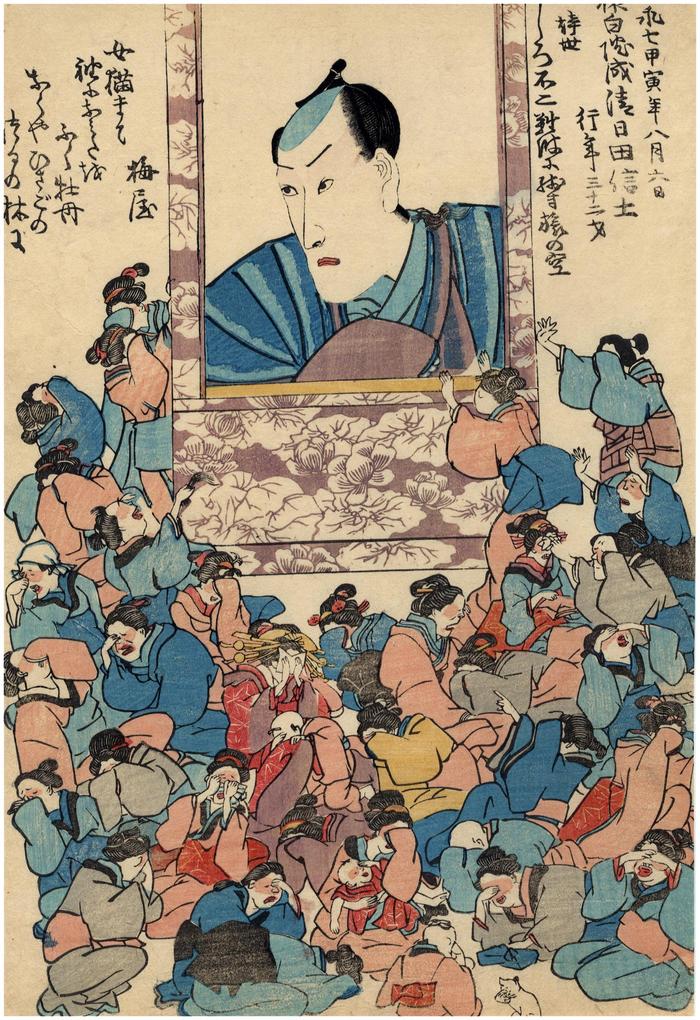Utagawa Kuniyoshi (歌川国芳) (artist 11/15/1797 – 03/05/1861)
Female admirers weeping before a large memorial portrait or shini-e (死絵) of the Ichikawa Danjūrō VIII
08/1854
9.5 in x 13.75 in (Overall dimensions) Color woodblock print
Waseda University
Achenbach Foundation - dated to 1856 - listed as by an unidentified artist
Tokyo Metropolitan Library
Chiba City_Museum of Art
Lyon Collection - diptych of the death of Buddha
Lyon Collection - Kuniyoshi print with a cat monster
Museum of Fine Arts, Boston - referred to as a parody of the death of the historical Buddha
Museum of Oriental Art, Venice (via Ritsumeikan University)
Edo-Tokyo Museum
National Gallery, Prague Like most shini-e or memorial prints this one is unsigned by the artist. Many scholars, collectors, dealers and museums have ascribed this print to Kuniyoshi. The weeping cat is one of the reasons many scholars believe this print my be by him. One site, Waseda University, says it is by Yoshimune, Kuniyoshi's pupil. Many sites online list this print as 'Artist unknown'. Therefore, until something absolute is found the attribution will be anyone's guess - even though stylistically it does look like a Kuniyoshi composition.
****
Julien Faury wrote about different paradigms of shini-e in an article in Arts asiatiques in 2011: "Si le schéma classique du shini-e offre généralement une image figée du défunt représenté dans le costume de son rôle phare (atari-yaku 当たり役) ou, comme nous venons de le voir, en hakama bleu en guise de linceul, certains ont également cherché à faire le lien entre ce monde et l’au-delà, soit en montrant ceux qui pleurent le défunt se lamenter devant le portrait de ce dernier, soit en mettant en scène l’accueil fait par ses prédécesseurs au nouveau venu."
The Google translation reads: "While the classic shini-e pattern generally offers a frozen image of the deceased depicted in the costume of his leading role (atari-yaku 当たり役) or, as we have just seen, in a blue hakama as a shroud, some have also sought to make a link between this world and the afterlife, either by showing those mourning the deceased lamenting in front of the latter's portrait, or by depicting the welcome given to the newcomer by his predecessors."
Faury notes that this motif of mourners before the hanging scroll basically shows a shini-e within a shini-e.
****
Illustrated in:
1) black and white in the section on Death and Dying in The Male Journey in Japanese Prints by Roger Keyes, University of California Press, page 184. This example can be found in the Achenbach Foundation collection, San Francisco.
2) color reproduction in Japanese Popular Prints: from votive slips to playing cards by Rebecca Salter, p. 129. That copy is in the National Museum of Japanese History.
3) color in "Memorial Portraits of Kabuki Actors: Fanfare in the Floating World" by Christine M. E. Guth, Impressions, #27, 2005-06, p. 28.
4) black and white in "Shini-e or "memorial portraits" in Andon 4, December 1981, #12, p. 98.
5) a small color reproduction in Heroes of the Kabuki Stage by Arendie and Henk Herwig, Hotei Publishing, 2004, #32, page 42.
****
There is another copy of this print in the National Gallery, Prague.
****
The text in the upper right reads:
嘉永七甲寅年八月六日
猿白院成清日田信士
行年三十二才
辞世
The next line reads:
うしろ不二難波に残す旅の空
Text on the other side says:
梅屋
女猫まで袖になみだを
ふく牡丹 なくやひさごの
つるの林に
****
Even the cat is weeping
There is an interesting curiosity at the bottom of this print: a weeping cat. While this might not leap out at you as particularly significant and may only appear to be a 'nice' touch, it is surprisingly more important than at first glance. Why? Because the cat was popularly believed to have been the only animal that didn't weep over the death of the historic Buddha.
Robert Schaap has speculated that, despite the Japanese love of cats, the use of monstrous cats in their prints and in their folklore may have been a result of an extrapolation from the belief that cats did not mourn the death of the Buddha properly. That is why we have added two links above to compositions in the Lyon Collection that seem to support this hypothesis. One is an image of a fearsome cat monster and the other is a vertical diptych where every creature from humans to insects are gathered to honor the Buddha, but not the cat. There is a lion, a tiger and also two cat-like animals that are probably a white fox and another unidentifiable creature, but nothing quite like a domesticated house cat.
It should be noted that the first to characters on the left side of the print are 女猫, which translates as 'female cat'.
****
Notice the lotus pads used on the border of the memorial image
In the Buddhist cosmology a person should want to be reborn in the Western Paradise of Amitabha. It is known as Sukhavati (Amitabha's Pure Land), Gokuraku in Japanese. According to the Buddhist canon, if a person is reborn into the Western Paradise he is first encapsulated the bud of lotus flower for an eon while he rids himself of self-doubt. After that the lotus opens up and the infant being has to spend another eon on the lotus pad before he can transition to the first tier of the glorious palace/temple of Sukhavati. And so on and on through time as the soul makes its way to becoming a higher being.
That explains the significance of the lotus pads that surround the portrait of the deceased actor hanging at the top center of this print.
Ichikawa Danjūrō VIII (八代目市川団十郎: 3/1832 - 6/8/1854) (actor)
actor prints (yakusha-e - 役者絵) (genre)
shini-e (死絵) (genre)
